Accurate Analysis of the Counselling Interventions and Responses
VerifiedAdded on 2022/08/20
|10
|2852
|31
AI Summary
Contribute Materials
Your contribution can guide someone’s learning journey. Share your
documents today.
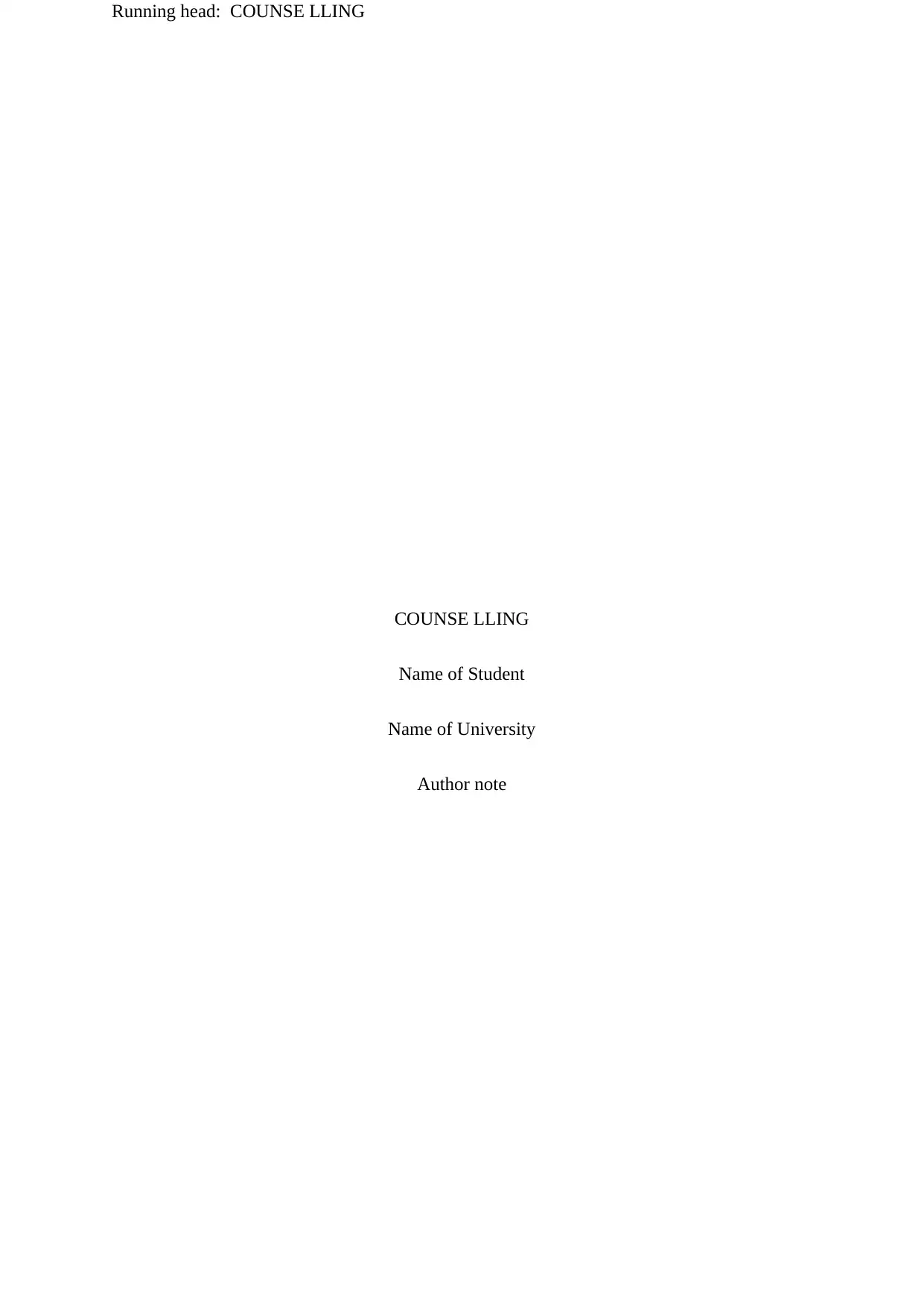
Running head: COUNSE LLING
COUNSE LLING
Name of Student
Name of University
Author note
COUNSE LLING
Name of Student
Name of University
Author note
Secure Best Marks with AI Grader
Need help grading? Try our AI Grader for instant feedback on your assignments.
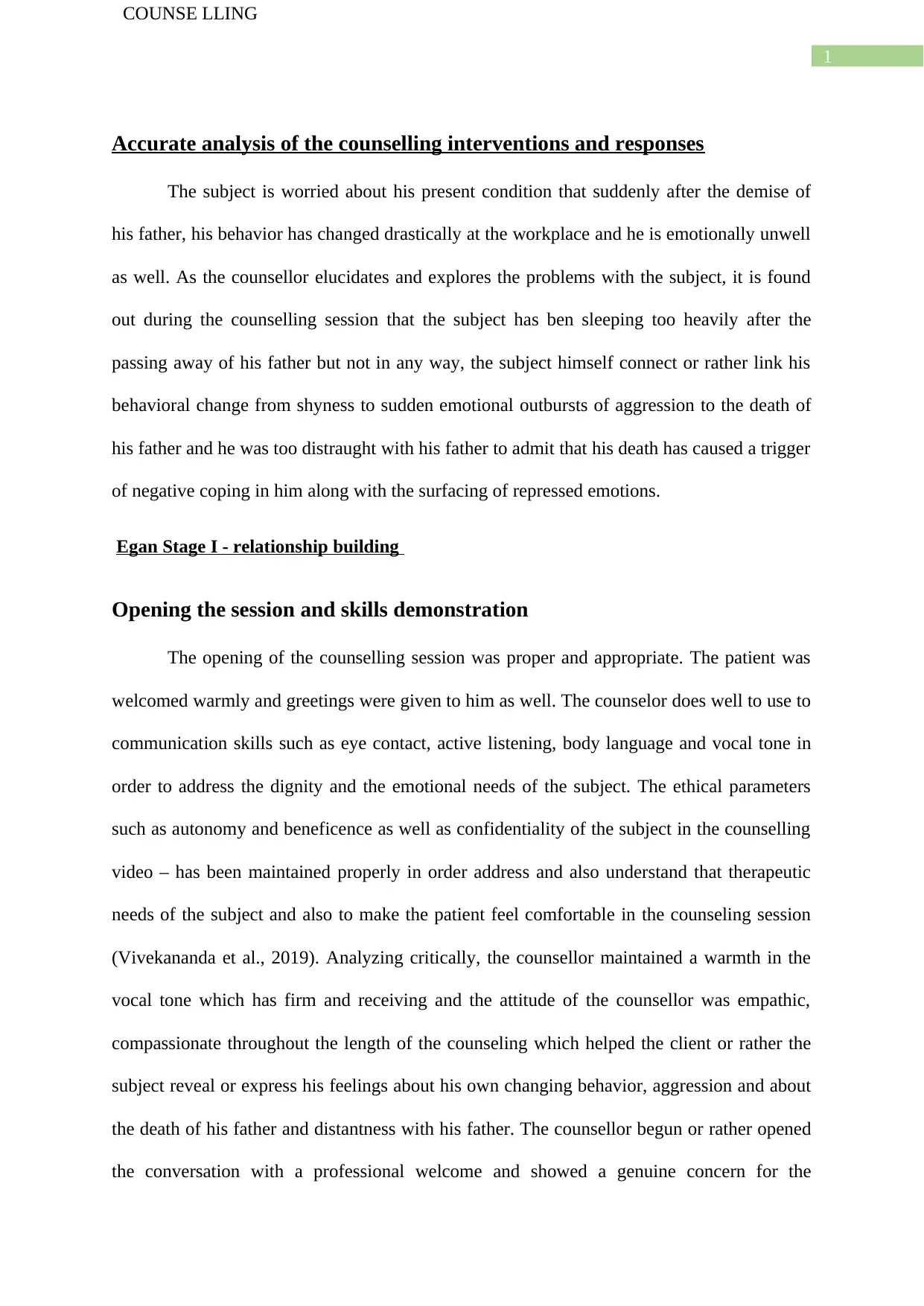
1
COUNSE LLING
Accurate analysis of the counselling interventions and responses
The subject is worried about his present condition that suddenly after the demise of
his father, his behavior has changed drastically at the workplace and he is emotionally unwell
as well. As the counsellor elucidates and explores the problems with the subject, it is found
out during the counselling session that the subject has ben sleeping too heavily after the
passing away of his father but not in any way, the subject himself connect or rather link his
behavioral change from shyness to sudden emotional outbursts of aggression to the death of
his father and he was too distraught with his father to admit that his death has caused a trigger
of negative coping in him along with the surfacing of repressed emotions.
Egan Stage I - relationship building
Opening the session and skills demonstration
The opening of the counselling session was proper and appropriate. The patient was
welcomed warmly and greetings were given to him as well. The counselor does well to use to
communication skills such as eye contact, active listening, body language and vocal tone in
order to address the dignity and the emotional needs of the subject. The ethical parameters
such as autonomy and beneficence as well as confidentiality of the subject in the counselling
video – has been maintained properly in order address and also understand that therapeutic
needs of the subject and also to make the patient feel comfortable in the counseling session
(Vivekananda et al., 2019). Analyzing critically, the counsellor maintained a warmth in the
vocal tone which has firm and receiving and the attitude of the counsellor was empathic,
compassionate throughout the length of the counseling which helped the client or rather the
subject reveal or express his feelings about his own changing behavior, aggression and about
the death of his father and distantness with his father. The counsellor begun or rather opened
the conversation with a professional welcome and showed a genuine concern for the
COUNSE LLING
Accurate analysis of the counselling interventions and responses
The subject is worried about his present condition that suddenly after the demise of
his father, his behavior has changed drastically at the workplace and he is emotionally unwell
as well. As the counsellor elucidates and explores the problems with the subject, it is found
out during the counselling session that the subject has ben sleeping too heavily after the
passing away of his father but not in any way, the subject himself connect or rather link his
behavioral change from shyness to sudden emotional outbursts of aggression to the death of
his father and he was too distraught with his father to admit that his death has caused a trigger
of negative coping in him along with the surfacing of repressed emotions.
Egan Stage I - relationship building
Opening the session and skills demonstration
The opening of the counselling session was proper and appropriate. The patient was
welcomed warmly and greetings were given to him as well. The counselor does well to use to
communication skills such as eye contact, active listening, body language and vocal tone in
order to address the dignity and the emotional needs of the subject. The ethical parameters
such as autonomy and beneficence as well as confidentiality of the subject in the counselling
video – has been maintained properly in order address and also understand that therapeutic
needs of the subject and also to make the patient feel comfortable in the counseling session
(Vivekananda et al., 2019). Analyzing critically, the counsellor maintained a warmth in the
vocal tone which has firm and receiving and the attitude of the counsellor was empathic,
compassionate throughout the length of the counseling which helped the client or rather the
subject reveal or express his feelings about his own changing behavior, aggression and about
the death of his father and distantness with his father. The counsellor begun or rather opened
the conversation with a professional welcome and showed a genuine concern for the
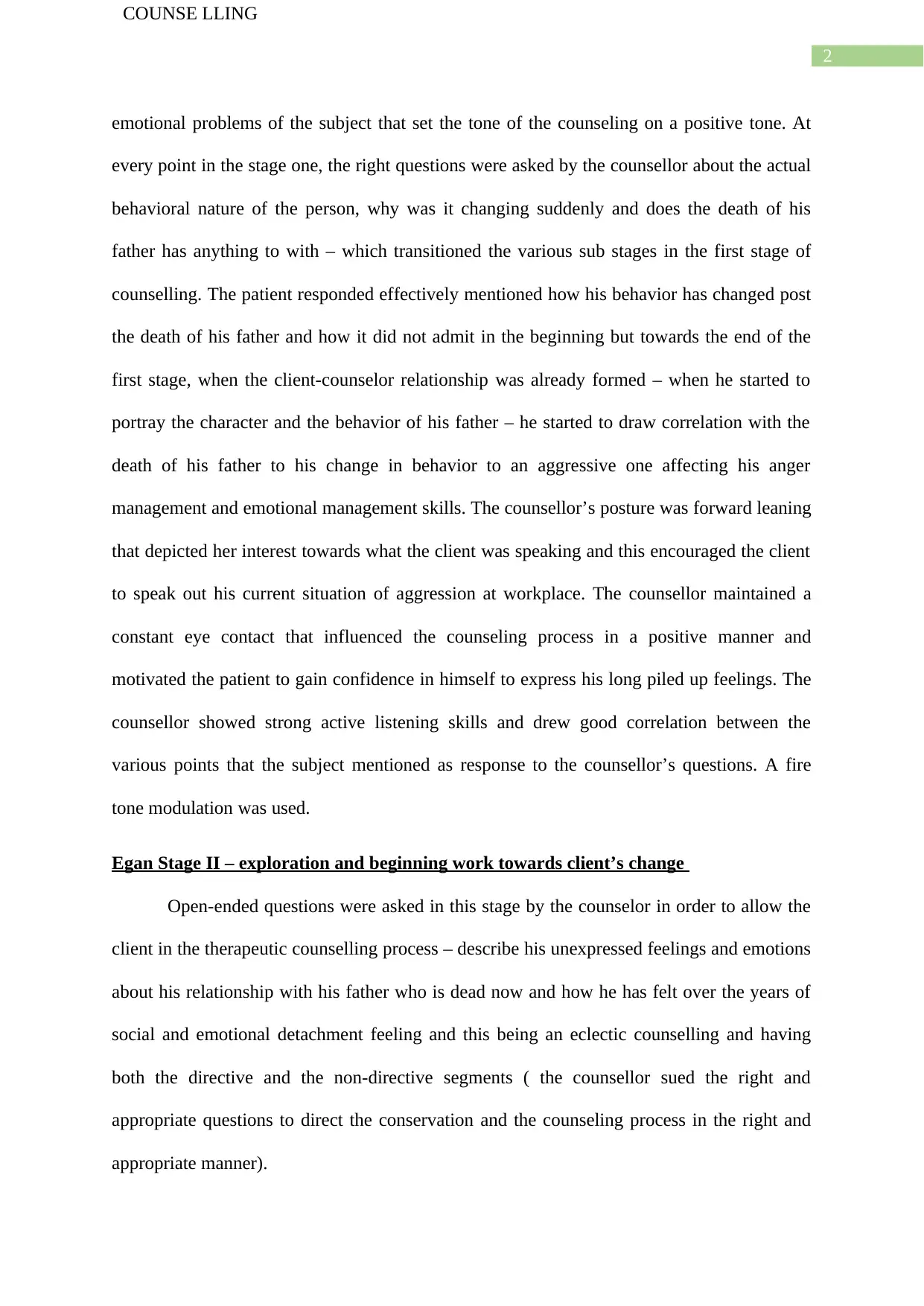
2
COUNSE LLING
emotional problems of the subject that set the tone of the counseling on a positive tone. At
every point in the stage one, the right questions were asked by the counsellor about the actual
behavioral nature of the person, why was it changing suddenly and does the death of his
father has anything to with – which transitioned the various sub stages in the first stage of
counselling. The patient responded effectively mentioned how his behavior has changed post
the death of his father and how it did not admit in the beginning but towards the end of the
first stage, when the client-counselor relationship was already formed – when he started to
portray the character and the behavior of his father – he started to draw correlation with the
death of his father to his change in behavior to an aggressive one affecting his anger
management and emotional management skills. The counsellor’s posture was forward leaning
that depicted her interest towards what the client was speaking and this encouraged the client
to speak out his current situation of aggression at workplace. The counsellor maintained a
constant eye contact that influenced the counseling process in a positive manner and
motivated the patient to gain confidence in himself to express his long piled up feelings. The
counsellor showed strong active listening skills and drew good correlation between the
various points that the subject mentioned as response to the counsellor’s questions. A fire
tone modulation was used.
Egan Stage II – exploration and beginning work towards client’s change
Open-ended questions were asked in this stage by the counselor in order to allow the
client in the therapeutic counselling process – describe his unexpressed feelings and emotions
about his relationship with his father who is dead now and how he has felt over the years of
social and emotional detachment feeling and this being an eclectic counselling and having
both the directive and the non-directive segments ( the counsellor sued the right and
appropriate questions to direct the conservation and the counseling process in the right and
appropriate manner).
COUNSE LLING
emotional problems of the subject that set the tone of the counseling on a positive tone. At
every point in the stage one, the right questions were asked by the counsellor about the actual
behavioral nature of the person, why was it changing suddenly and does the death of his
father has anything to with – which transitioned the various sub stages in the first stage of
counselling. The patient responded effectively mentioned how his behavior has changed post
the death of his father and how it did not admit in the beginning but towards the end of the
first stage, when the client-counselor relationship was already formed – when he started to
portray the character and the behavior of his father – he started to draw correlation with the
death of his father to his change in behavior to an aggressive one affecting his anger
management and emotional management skills. The counsellor’s posture was forward leaning
that depicted her interest towards what the client was speaking and this encouraged the client
to speak out his current situation of aggression at workplace. The counsellor maintained a
constant eye contact that influenced the counseling process in a positive manner and
motivated the patient to gain confidence in himself to express his long piled up feelings. The
counsellor showed strong active listening skills and drew good correlation between the
various points that the subject mentioned as response to the counsellor’s questions. A fire
tone modulation was used.
Egan Stage II – exploration and beginning work towards client’s change
Open-ended questions were asked in this stage by the counselor in order to allow the
client in the therapeutic counselling process – describe his unexpressed feelings and emotions
about his relationship with his father who is dead now and how he has felt over the years of
social and emotional detachment feeling and this being an eclectic counselling and having
both the directive and the non-directive segments ( the counsellor sued the right and
appropriate questions to direct the conservation and the counseling process in the right and
appropriate manner).
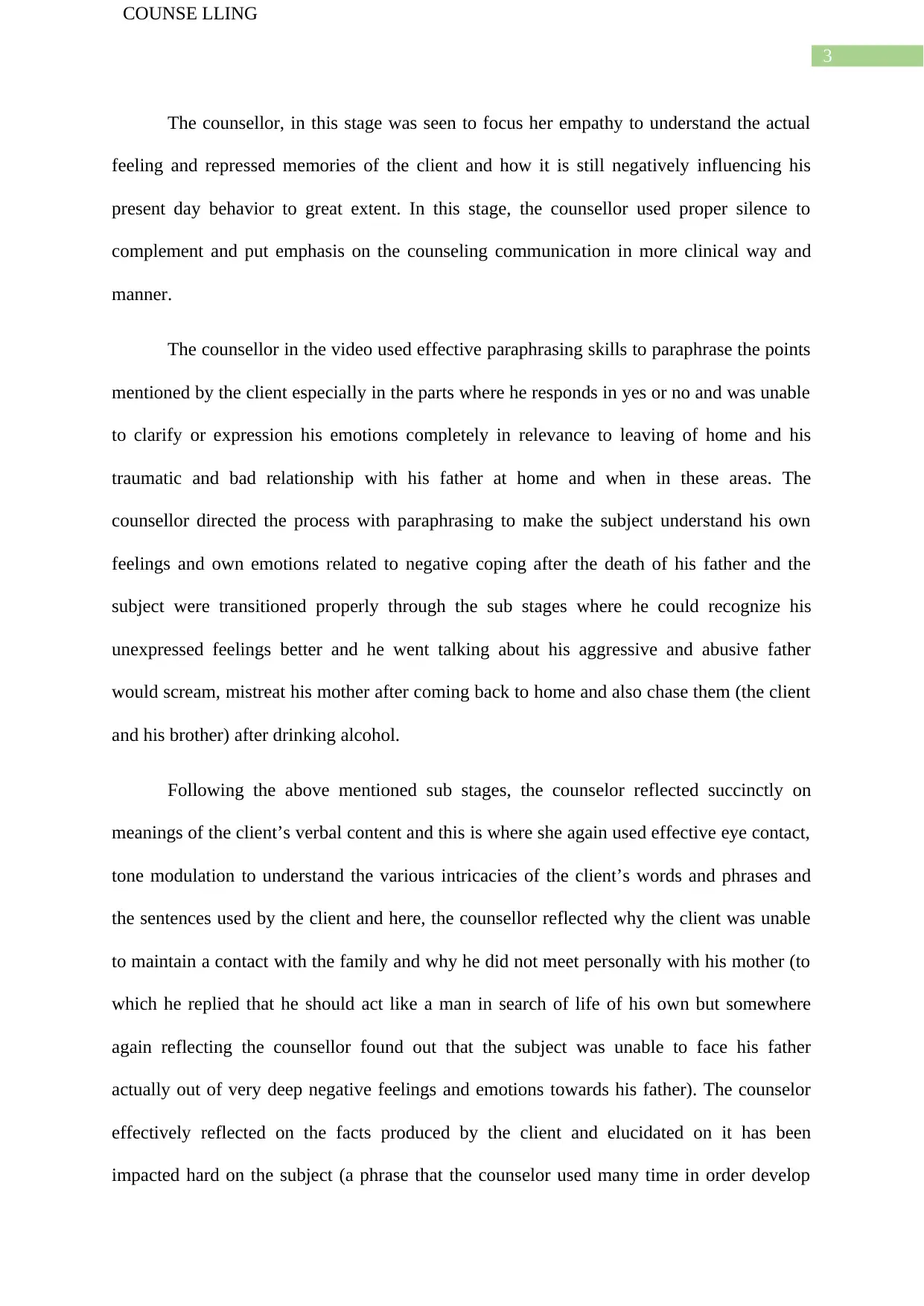
3
COUNSE LLING
The counsellor, in this stage was seen to focus her empathy to understand the actual
feeling and repressed memories of the client and how it is still negatively influencing his
present day behavior to great extent. In this stage, the counsellor used proper silence to
complement and put emphasis on the counseling communication in more clinical way and
manner.
The counsellor in the video used effective paraphrasing skills to paraphrase the points
mentioned by the client especially in the parts where he responds in yes or no and was unable
to clarify or expression his emotions completely in relevance to leaving of home and his
traumatic and bad relationship with his father at home and when in these areas. The
counsellor directed the process with paraphrasing to make the subject understand his own
feelings and own emotions related to negative coping after the death of his father and the
subject were transitioned properly through the sub stages where he could recognize his
unexpressed feelings better and he went talking about his aggressive and abusive father
would scream, mistreat his mother after coming back to home and also chase them (the client
and his brother) after drinking alcohol.
Following the above mentioned sub stages, the counselor reflected succinctly on
meanings of the client’s verbal content and this is where she again used effective eye contact,
tone modulation to understand the various intricacies of the client’s words and phrases and
the sentences used by the client and here, the counsellor reflected why the client was unable
to maintain a contact with the family and why he did not meet personally with his mother (to
which he replied that he should act like a man in search of life of his own but somewhere
again reflecting the counsellor found out that the subject was unable to face his father
actually out of very deep negative feelings and emotions towards his father). The counselor
effectively reflected on the facts produced by the client and elucidated on it has been
impacted hard on the subject (a phrase that the counselor used many time in order develop
COUNSE LLING
The counsellor, in this stage was seen to focus her empathy to understand the actual
feeling and repressed memories of the client and how it is still negatively influencing his
present day behavior to great extent. In this stage, the counsellor used proper silence to
complement and put emphasis on the counseling communication in more clinical way and
manner.
The counsellor in the video used effective paraphrasing skills to paraphrase the points
mentioned by the client especially in the parts where he responds in yes or no and was unable
to clarify or expression his emotions completely in relevance to leaving of home and his
traumatic and bad relationship with his father at home and when in these areas. The
counsellor directed the process with paraphrasing to make the subject understand his own
feelings and own emotions related to negative coping after the death of his father and the
subject were transitioned properly through the sub stages where he could recognize his
unexpressed feelings better and he went talking about his aggressive and abusive father
would scream, mistreat his mother after coming back to home and also chase them (the client
and his brother) after drinking alcohol.
Following the above mentioned sub stages, the counselor reflected succinctly on
meanings of the client’s verbal content and this is where she again used effective eye contact,
tone modulation to understand the various intricacies of the client’s words and phrases and
the sentences used by the client and here, the counsellor reflected why the client was unable
to maintain a contact with the family and why he did not meet personally with his mother (to
which he replied that he should act like a man in search of life of his own but somewhere
again reflecting the counsellor found out that the subject was unable to face his father
actually out of very deep negative feelings and emotions towards his father). The counselor
effectively reflected on the facts produced by the client and elucidated on it has been
impacted hard on the subject (a phrase that the counselor used many time in order develop
Secure Best Marks with AI Grader
Need help grading? Try our AI Grader for instant feedback on your assignments.
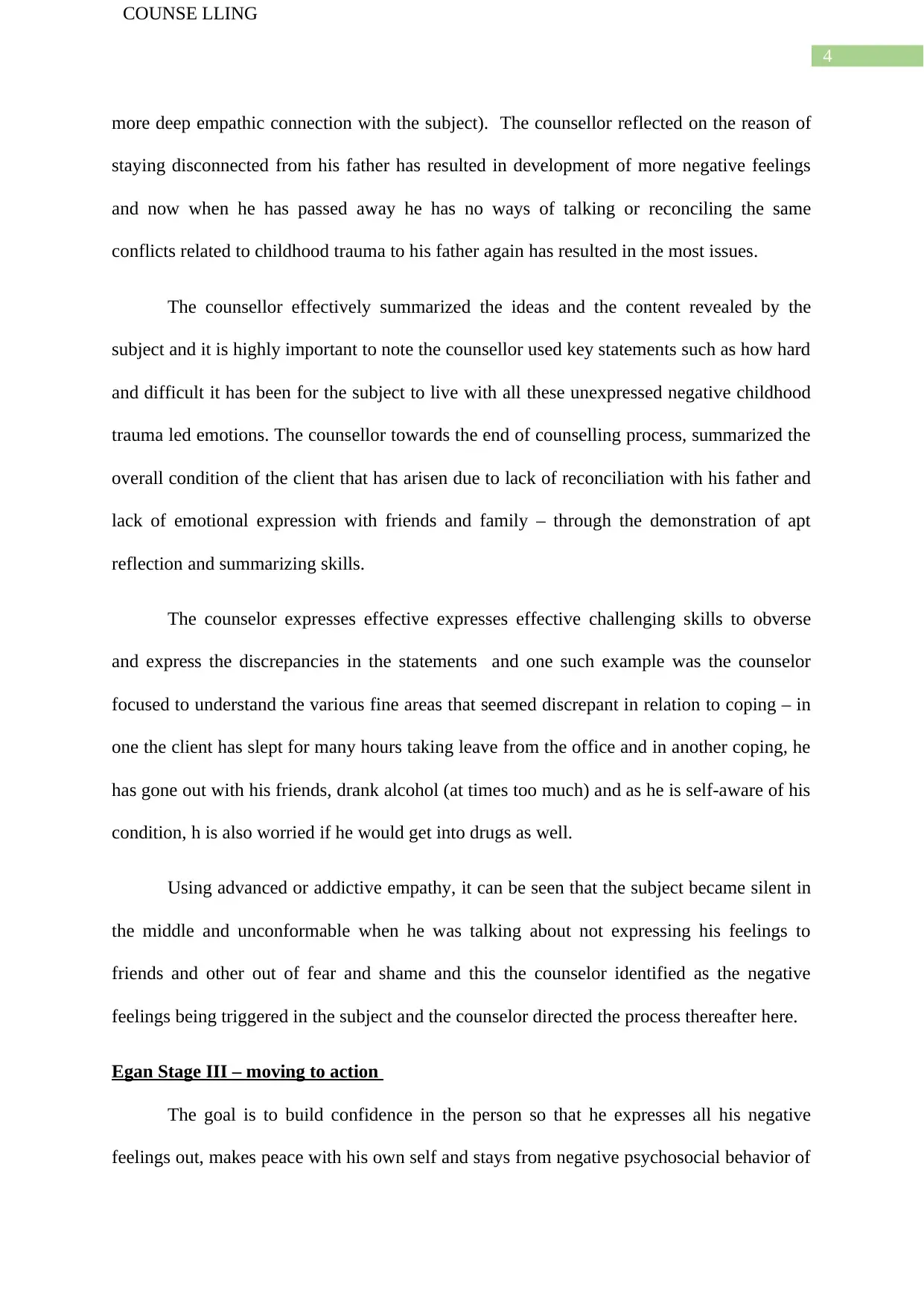
4
COUNSE LLING
more deep empathic connection with the subject). The counsellor reflected on the reason of
staying disconnected from his father has resulted in development of more negative feelings
and now when he has passed away he has no ways of talking or reconciling the same
conflicts related to childhood trauma to his father again has resulted in the most issues.
The counsellor effectively summarized the ideas and the content revealed by the
subject and it is highly important to note the counsellor used key statements such as how hard
and difficult it has been for the subject to live with all these unexpressed negative childhood
trauma led emotions. The counsellor towards the end of counselling process, summarized the
overall condition of the client that has arisen due to lack of reconciliation with his father and
lack of emotional expression with friends and family – through the demonstration of apt
reflection and summarizing skills.
The counselor expresses effective expresses effective challenging skills to obverse
and express the discrepancies in the statements and one such example was the counselor
focused to understand the various fine areas that seemed discrepant in relation to coping – in
one the client has slept for many hours taking leave from the office and in another coping, he
has gone out with his friends, drank alcohol (at times too much) and as he is self-aware of his
condition, h is also worried if he would get into drugs as well.
Using advanced or addictive empathy, it can be seen that the subject became silent in
the middle and unconformable when he was talking about not expressing his feelings to
friends and other out of fear and shame and this the counselor identified as the negative
feelings being triggered in the subject and the counselor directed the process thereafter here.
Egan Stage III – moving to action
The goal is to build confidence in the person so that he expresses all his negative
feelings out, makes peace with his own self and stays from negative psychosocial behavior of
COUNSE LLING
more deep empathic connection with the subject). The counsellor reflected on the reason of
staying disconnected from his father has resulted in development of more negative feelings
and now when he has passed away he has no ways of talking or reconciling the same
conflicts related to childhood trauma to his father again has resulted in the most issues.
The counsellor effectively summarized the ideas and the content revealed by the
subject and it is highly important to note the counsellor used key statements such as how hard
and difficult it has been for the subject to live with all these unexpressed negative childhood
trauma led emotions. The counsellor towards the end of counselling process, summarized the
overall condition of the client that has arisen due to lack of reconciliation with his father and
lack of emotional expression with friends and family – through the demonstration of apt
reflection and summarizing skills.
The counselor expresses effective expresses effective challenging skills to obverse
and express the discrepancies in the statements and one such example was the counselor
focused to understand the various fine areas that seemed discrepant in relation to coping – in
one the client has slept for many hours taking leave from the office and in another coping, he
has gone out with his friends, drank alcohol (at times too much) and as he is self-aware of his
condition, h is also worried if he would get into drugs as well.
Using advanced or addictive empathy, it can be seen that the subject became silent in
the middle and unconformable when he was talking about not expressing his feelings to
friends and other out of fear and shame and this the counselor identified as the negative
feelings being triggered in the subject and the counselor directed the process thereafter here.
Egan Stage III – moving to action
The goal is to build confidence in the person so that he expresses all his negative
feelings out, makes peace with his own self and stays from negative psychosocial behavior of
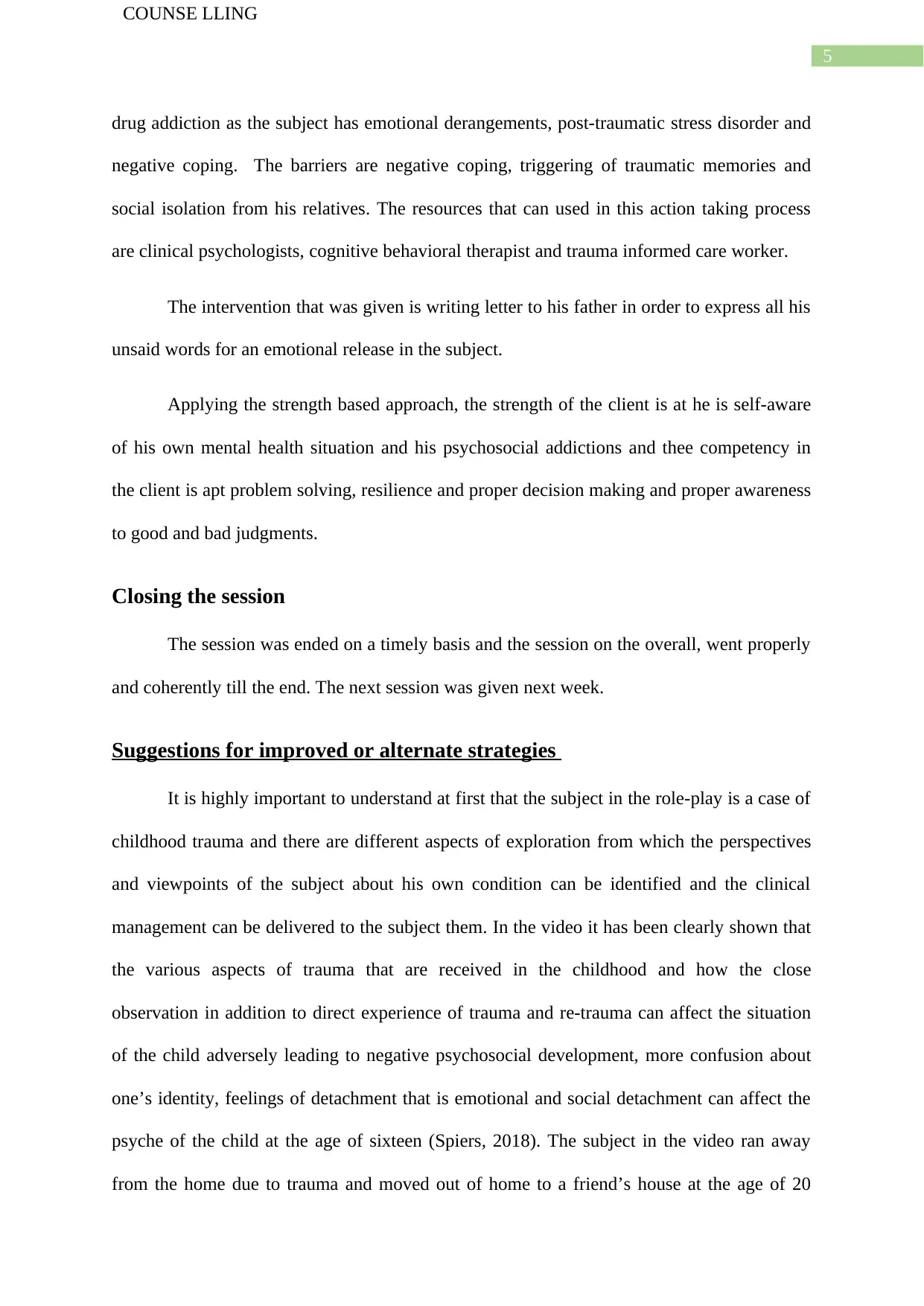
5
COUNSE LLING
drug addiction as the subject has emotional derangements, post-traumatic stress disorder and
negative coping. The barriers are negative coping, triggering of traumatic memories and
social isolation from his relatives. The resources that can used in this action taking process
are clinical psychologists, cognitive behavioral therapist and trauma informed care worker.
The intervention that was given is writing letter to his father in order to express all his
unsaid words for an emotional release in the subject.
Applying the strength based approach, the strength of the client is at he is self-aware
of his own mental health situation and his psychosocial addictions and thee competency in
the client is apt problem solving, resilience and proper decision making and proper awareness
to good and bad judgments.
Closing the session
The session was ended on a timely basis and the session on the overall, went properly
and coherently till the end. The next session was given next week.
Suggestions for improved or alternate strategies
It is highly important to understand at first that the subject in the role-play is a case of
childhood trauma and there are different aspects of exploration from which the perspectives
and viewpoints of the subject about his own condition can be identified and the clinical
management can be delivered to the subject them. In the video it has been clearly shown that
the various aspects of trauma that are received in the childhood and how the close
observation in addition to direct experience of trauma and re-trauma can affect the situation
of the child adversely leading to negative psychosocial development, more confusion about
one’s identity, feelings of detachment that is emotional and social detachment can affect the
psyche of the child at the age of sixteen (Spiers, 2018). The subject in the video ran away
from the home due to trauma and moved out of home to a friend’s house at the age of 20
COUNSE LLING
drug addiction as the subject has emotional derangements, post-traumatic stress disorder and
negative coping. The barriers are negative coping, triggering of traumatic memories and
social isolation from his relatives. The resources that can used in this action taking process
are clinical psychologists, cognitive behavioral therapist and trauma informed care worker.
The intervention that was given is writing letter to his father in order to express all his
unsaid words for an emotional release in the subject.
Applying the strength based approach, the strength of the client is at he is self-aware
of his own mental health situation and his psychosocial addictions and thee competency in
the client is apt problem solving, resilience and proper decision making and proper awareness
to good and bad judgments.
Closing the session
The session was ended on a timely basis and the session on the overall, went properly
and coherently till the end. The next session was given next week.
Suggestions for improved or alternate strategies
It is highly important to understand at first that the subject in the role-play is a case of
childhood trauma and there are different aspects of exploration from which the perspectives
and viewpoints of the subject about his own condition can be identified and the clinical
management can be delivered to the subject them. In the video it has been clearly shown that
the various aspects of trauma that are received in the childhood and how the close
observation in addition to direct experience of trauma and re-trauma can affect the situation
of the child adversely leading to negative psychosocial development, more confusion about
one’s identity, feelings of detachment that is emotional and social detachment can affect the
psyche of the child at the age of sixteen (Spiers, 2018). The subject in the video ran away
from the home due to trauma and moved out of home to a friend’s house at the age of 20
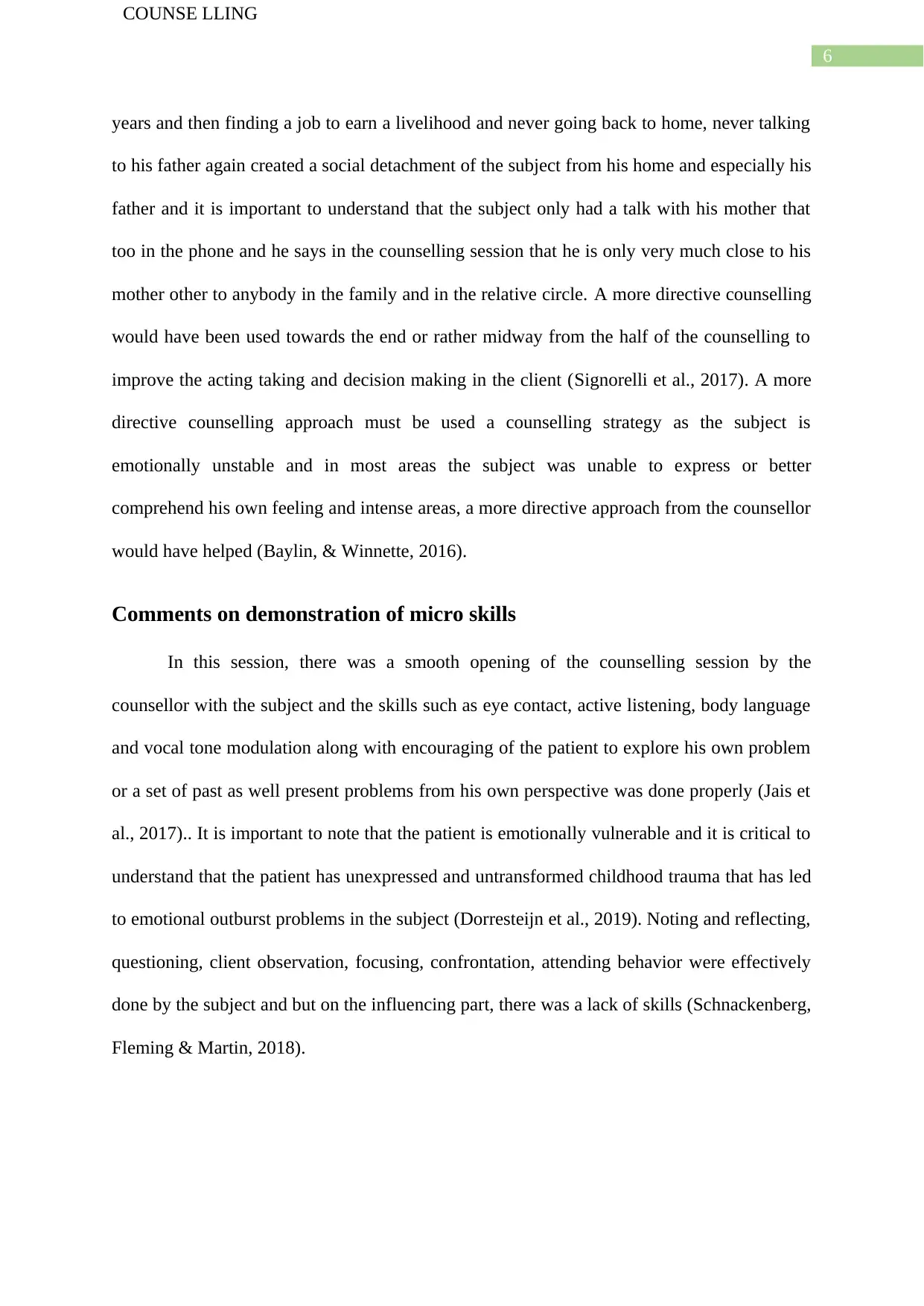
6
COUNSE LLING
years and then finding a job to earn a livelihood and never going back to home, never talking
to his father again created a social detachment of the subject from his home and especially his
father and it is important to understand that the subject only had a talk with his mother that
too in the phone and he says in the counselling session that he is only very much close to his
mother other to anybody in the family and in the relative circle. A more directive counselling
would have been used towards the end or rather midway from the half of the counselling to
improve the acting taking and decision making in the client (Signorelli et al., 2017). A more
directive counselling approach must be used a counselling strategy as the subject is
emotionally unstable and in most areas the subject was unable to express or better
comprehend his own feeling and intense areas, a more directive approach from the counsellor
would have helped (Baylin, & Winnette, 2016).
Comments on demonstration of micro skills
In this session, there was a smooth opening of the counselling session by the
counsellor with the subject and the skills such as eye contact, active listening, body language
and vocal tone modulation along with encouraging of the patient to explore his own problem
or a set of past as well present problems from his own perspective was done properly (Jais et
al., 2017).. It is important to note that the patient is emotionally vulnerable and it is critical to
understand that the patient has unexpressed and untransformed childhood trauma that has led
to emotional outburst problems in the subject (Dorresteijn et al., 2019). Noting and reflecting,
questioning, client observation, focusing, confrontation, attending behavior were effectively
done by the subject and but on the influencing part, there was a lack of skills (Schnackenberg,
Fleming & Martin, 2018).
COUNSE LLING
years and then finding a job to earn a livelihood and never going back to home, never talking
to his father again created a social detachment of the subject from his home and especially his
father and it is important to understand that the subject only had a talk with his mother that
too in the phone and he says in the counselling session that he is only very much close to his
mother other to anybody in the family and in the relative circle. A more directive counselling
would have been used towards the end or rather midway from the half of the counselling to
improve the acting taking and decision making in the client (Signorelli et al., 2017). A more
directive counselling approach must be used a counselling strategy as the subject is
emotionally unstable and in most areas the subject was unable to express or better
comprehend his own feeling and intense areas, a more directive approach from the counsellor
would have helped (Baylin, & Winnette, 2016).
Comments on demonstration of micro skills
In this session, there was a smooth opening of the counselling session by the
counsellor with the subject and the skills such as eye contact, active listening, body language
and vocal tone modulation along with encouraging of the patient to explore his own problem
or a set of past as well present problems from his own perspective was done properly (Jais et
al., 2017).. It is important to note that the patient is emotionally vulnerable and it is critical to
understand that the patient has unexpressed and untransformed childhood trauma that has led
to emotional outburst problems in the subject (Dorresteijn et al., 2019). Noting and reflecting,
questioning, client observation, focusing, confrontation, attending behavior were effectively
done by the subject and but on the influencing part, there was a lack of skills (Schnackenberg,
Fleming & Martin, 2018).
Paraphrase This Document
Need a fresh take? Get an instant paraphrase of this document with our AI Paraphraser
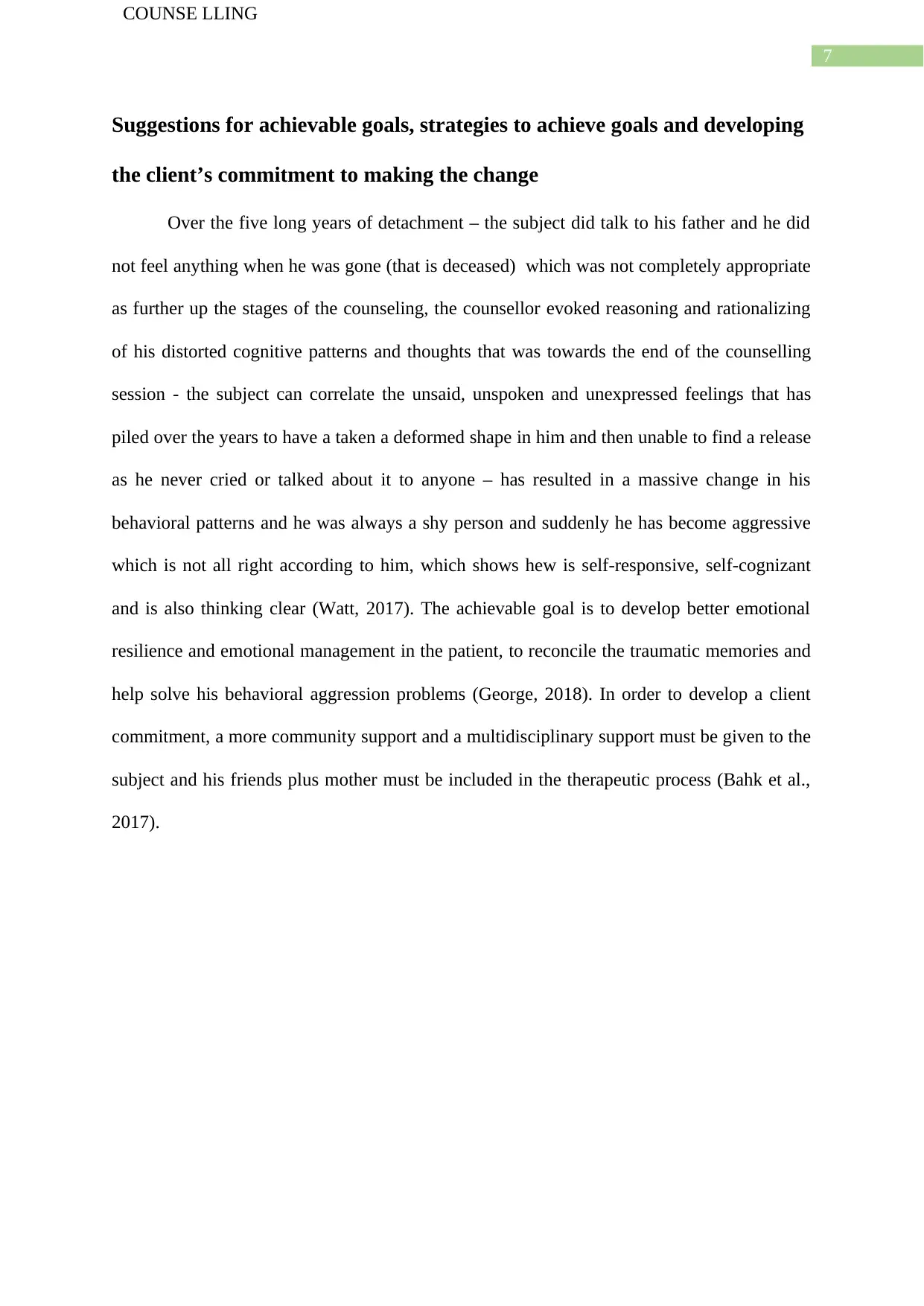
7
COUNSE LLING
Suggestions for achievable goals, strategies to achieve goals and developing
the client’s commitment to making the change
Over the five long years of detachment – the subject did talk to his father and he did
not feel anything when he was gone (that is deceased) which was not completely appropriate
as further up the stages of the counseling, the counsellor evoked reasoning and rationalizing
of his distorted cognitive patterns and thoughts that was towards the end of the counselling
session - the subject can correlate the unsaid, unspoken and unexpressed feelings that has
piled over the years to have a taken a deformed shape in him and then unable to find a release
as he never cried or talked about it to anyone – has resulted in a massive change in his
behavioral patterns and he was always a shy person and suddenly he has become aggressive
which is not all right according to him, which shows hew is self-responsive, self-cognizant
and is also thinking clear (Watt, 2017). The achievable goal is to develop better emotional
resilience and emotional management in the patient, to reconcile the traumatic memories and
help solve his behavioral aggression problems (George, 2018). In order to develop a client
commitment, a more community support and a multidisciplinary support must be given to the
subject and his friends plus mother must be included in the therapeutic process (Bahk et al.,
2017).
COUNSE LLING
Suggestions for achievable goals, strategies to achieve goals and developing
the client’s commitment to making the change
Over the five long years of detachment – the subject did talk to his father and he did
not feel anything when he was gone (that is deceased) which was not completely appropriate
as further up the stages of the counseling, the counsellor evoked reasoning and rationalizing
of his distorted cognitive patterns and thoughts that was towards the end of the counselling
session - the subject can correlate the unsaid, unspoken and unexpressed feelings that has
piled over the years to have a taken a deformed shape in him and then unable to find a release
as he never cried or talked about it to anyone – has resulted in a massive change in his
behavioral patterns and he was always a shy person and suddenly he has become aggressive
which is not all right according to him, which shows hew is self-responsive, self-cognizant
and is also thinking clear (Watt, 2017). The achievable goal is to develop better emotional
resilience and emotional management in the patient, to reconcile the traumatic memories and
help solve his behavioral aggression problems (George, 2018). In order to develop a client
commitment, a more community support and a multidisciplinary support must be given to the
subject and his friends plus mother must be included in the therapeutic process (Bahk et al.,
2017).
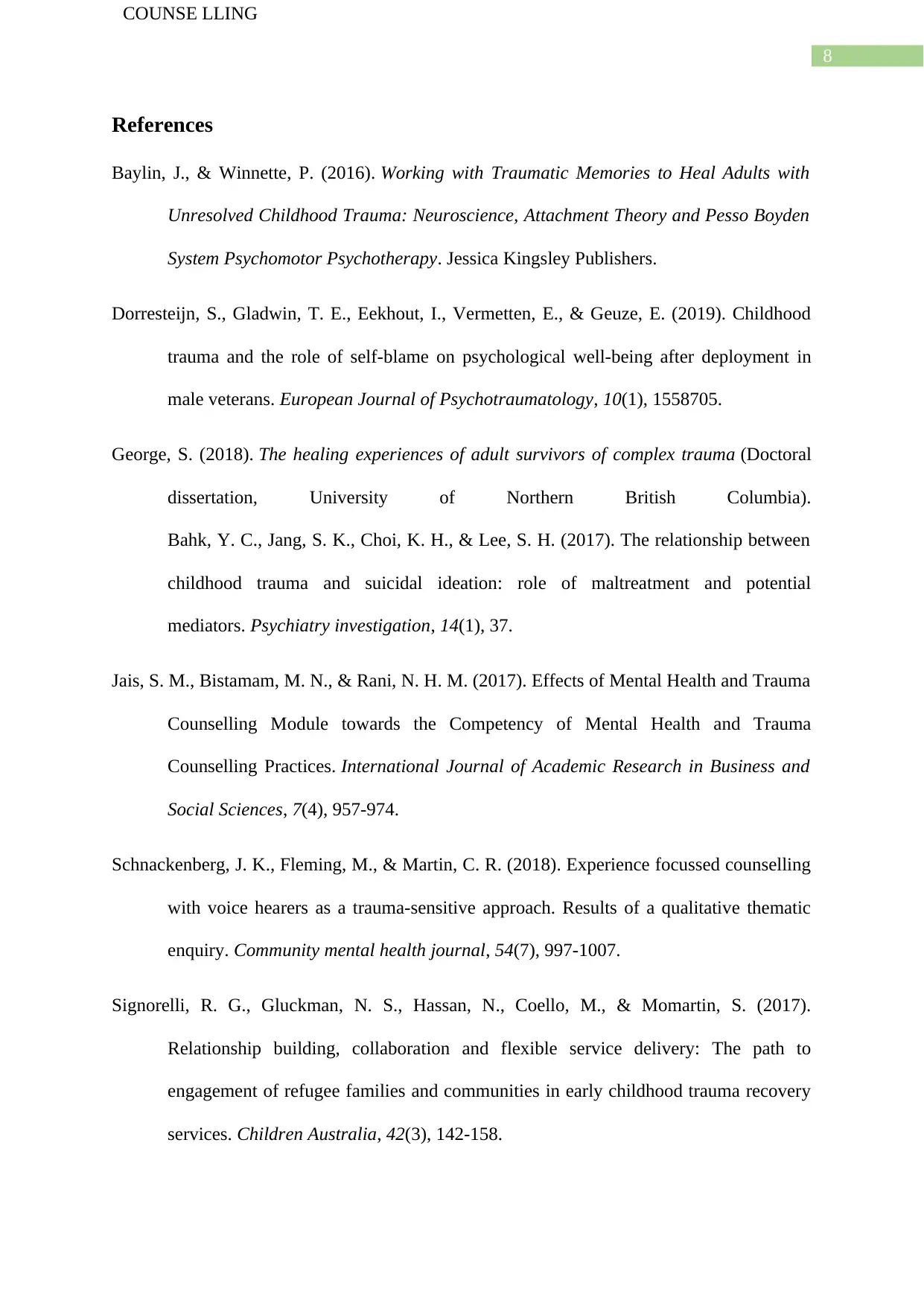
8
COUNSE LLING
References
Baylin, J., & Winnette, P. (2016). Working with Traumatic Memories to Heal Adults with
Unresolved Childhood Trauma: Neuroscience, Attachment Theory and Pesso Boyden
System Psychomotor Psychotherapy. Jessica Kingsley Publishers.
Dorresteijn, S., Gladwin, T. E., Eekhout, I., Vermetten, E., & Geuze, E. (2019). Childhood
trauma and the role of self-blame on psychological well-being after deployment in
male veterans. European Journal of Psychotraumatology, 10(1), 1558705.
George, S. (2018). The healing experiences of adult survivors of complex trauma (Doctoral
dissertation, University of Northern British Columbia).
Bahk, Y. C., Jang, S. K., Choi, K. H., & Lee, S. H. (2017). The relationship between
childhood trauma and suicidal ideation: role of maltreatment and potential
mediators. Psychiatry investigation, 14(1), 37.
Jais, S. M., Bistamam, M. N., & Rani, N. H. M. (2017). Effects of Mental Health and Trauma
Counselling Module towards the Competency of Mental Health and Trauma
Counselling Practices. International Journal of Academic Research in Business and
Social Sciences, 7(4), 957-974.
Schnackenberg, J. K., Fleming, M., & Martin, C. R. (2018). Experience focussed counselling
with voice hearers as a trauma-sensitive approach. Results of a qualitative thematic
enquiry. Community mental health journal, 54(7), 997-1007.
Signorelli, R. G., Gluckman, N. S., Hassan, N., Coello, M., & Momartin, S. (2017).
Relationship building, collaboration and flexible service delivery: The path to
engagement of refugee families and communities in early childhood trauma recovery
services. Children Australia, 42(3), 142-158.
COUNSE LLING
References
Baylin, J., & Winnette, P. (2016). Working with Traumatic Memories to Heal Adults with
Unresolved Childhood Trauma: Neuroscience, Attachment Theory and Pesso Boyden
System Psychomotor Psychotherapy. Jessica Kingsley Publishers.
Dorresteijn, S., Gladwin, T. E., Eekhout, I., Vermetten, E., & Geuze, E. (2019). Childhood
trauma and the role of self-blame on psychological well-being after deployment in
male veterans. European Journal of Psychotraumatology, 10(1), 1558705.
George, S. (2018). The healing experiences of adult survivors of complex trauma (Doctoral
dissertation, University of Northern British Columbia).
Bahk, Y. C., Jang, S. K., Choi, K. H., & Lee, S. H. (2017). The relationship between
childhood trauma and suicidal ideation: role of maltreatment and potential
mediators. Psychiatry investigation, 14(1), 37.
Jais, S. M., Bistamam, M. N., & Rani, N. H. M. (2017). Effects of Mental Health and Trauma
Counselling Module towards the Competency of Mental Health and Trauma
Counselling Practices. International Journal of Academic Research in Business and
Social Sciences, 7(4), 957-974.
Schnackenberg, J. K., Fleming, M., & Martin, C. R. (2018). Experience focussed counselling
with voice hearers as a trauma-sensitive approach. Results of a qualitative thematic
enquiry. Community mental health journal, 54(7), 997-1007.
Signorelli, R. G., Gluckman, N. S., Hassan, N., Coello, M., & Momartin, S. (2017).
Relationship building, collaboration and flexible service delivery: The path to
engagement of refugee families and communities in early childhood trauma recovery
services. Children Australia, 42(3), 142-158.
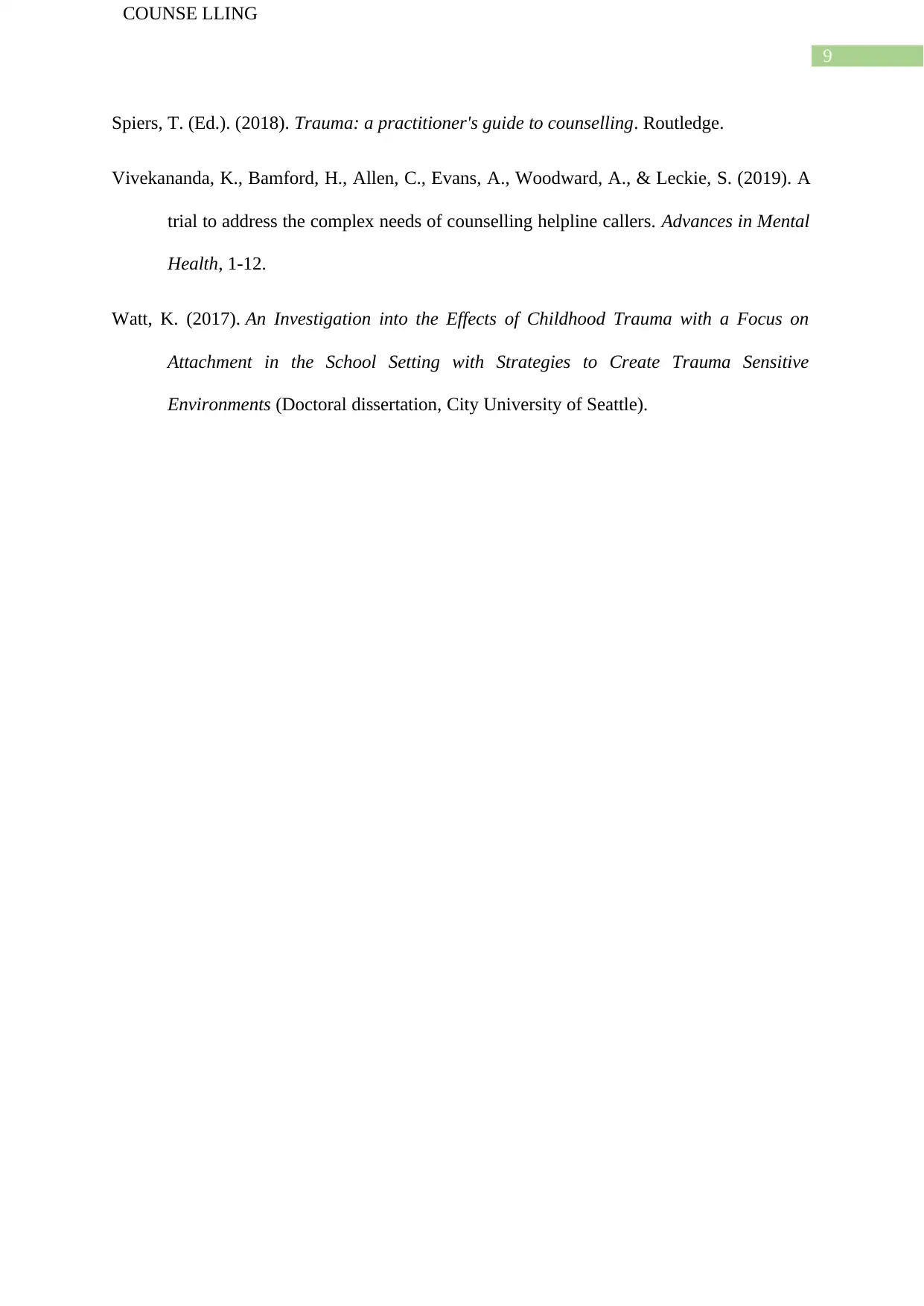
9
COUNSE LLING
Spiers, T. (Ed.). (2018). Trauma: a practitioner's guide to counselling. Routledge.
Vivekananda, K., Bamford, H., Allen, C., Evans, A., Woodward, A., & Leckie, S. (2019). A
trial to address the complex needs of counselling helpline callers. Advances in Mental
Health, 1-12.
Watt, K. (2017). An Investigation into the Effects of Childhood Trauma with a Focus on
Attachment in the School Setting with Strategies to Create Trauma Sensitive
Environments (Doctoral dissertation, City University of Seattle).
COUNSE LLING
Spiers, T. (Ed.). (2018). Trauma: a practitioner's guide to counselling. Routledge.
Vivekananda, K., Bamford, H., Allen, C., Evans, A., Woodward, A., & Leckie, S. (2019). A
trial to address the complex needs of counselling helpline callers. Advances in Mental
Health, 1-12.
Watt, K. (2017). An Investigation into the Effects of Childhood Trauma with a Focus on
Attachment in the School Setting with Strategies to Create Trauma Sensitive
Environments (Doctoral dissertation, City University of Seattle).
1 out of 10
Your All-in-One AI-Powered Toolkit for Academic Success.
+13062052269
info@desklib.com
Available 24*7 on WhatsApp / Email
![[object Object]](/_next/static/media/star-bottom.7253800d.svg)
Unlock your academic potential
© 2024 | Zucol Services PVT LTD | All rights reserved.